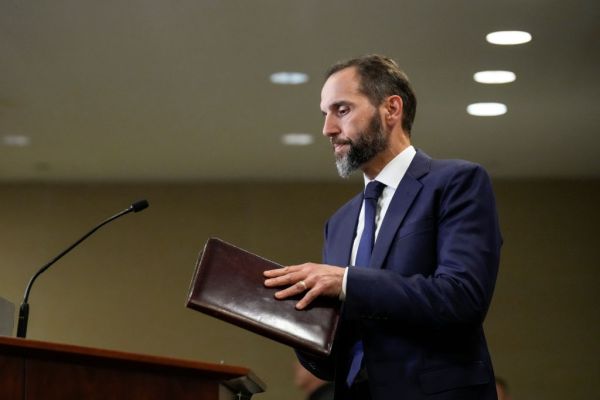The investigations into the retention and mishandling of classified documents two years ago revealed a problem that wasn’t partisan—both Donald Trump and Joe Biden had classified material in their residences—and it wasn’t even just presidential, as former Vice President Mike Pence had also retained documents. But they also revealed a larger problem beyond having state secrets piled up in a garage or spare bathroom: Our classification system is broken.
Overclassification is the first, and perhaps biggest problem, because it creates other downstream issues. Our government produces about 50 million classified documents a year, according to the latest count of the Information Security Oversight Office some years ago.
Not only does the government produce an ever-increasing amount of information, executive branch personnel are incentivized to overclassify documents: Marking a whole batch of related material as classified is much faster than sorting through individual documents to see what meets the threshold. And no one wants to be the person who made the wrong decision, so it’s safer to err on the side of classifying.
Still, there are downsides: Maintaining the sheer volume of classified material costs taxpayers $18 billion a year, and Congress has found anywhere from 50 to 90 percent of these documents did not warrant classification. As an attorney for both the Senate Foreign Relations and House Foreign Affairs committees who regularly reviewed classified information for years on Capitol Hill, that number seems correct to me. I often found something I read in the newspaper days earlier or heard discussed on cable news among the classified information that I reviewed.
Such liberal classification policies erode trust in our government and limit transparency for American citizens. But overclassification also hampers the ability of the government itself to function.
In the years since 9/11, executive departments have improved the sharing of classified information among themselves through creation of the Office of the Director of National Intelligence and consolidation into the Department of Homeland Security. Nevertheless, turf wars, resource constraints, and backlogs hamper sharing inside the government. Just this past December, the inspector general for the intelligence community found a number of deficiencies regarding intra-government sharing of cyberthreat information, including inconsistent sharing policies across departments, technological systems that can’t interface with one another, and fear of what the receiving departments would do with the information.
Or take Congress. Members of Congress have the ability to review classified material by virtue of their position, but gaining access to that information isn’t easy. Unless you are a member of the Intelligence Committee or a chairman or ranking member of a security-related committee like Foreign Affairs or Armed Services, you won’t see a lot of classified material—at least not enough to be fully informed before some key votes.
If you are a member of the Agriculture Committee, let’s say, or even a rank-and-file member of a security committee, and you want to see some top-secret documents to inform how you should vote on a military aid bill to a given country, well … good luck. That’s because Congress has surrendered the field when it comes to deciding which of its members can view which documents. Most of that hierarchy is determined by the executive branch. While it is lawful for members to access top secret information, the executive branch would prefer that such information is shared on a “need to know” basis—as determined by the executive branch. And in case you’re wondering, the need to be informed before you cast a vote on behalf of your constituents doesn’t really count.
Can members ask committee chairs to summarize classified information? Maybe. But they can’t just walk up to the chairman on the floor of the House between votes and ask about the material. A member has to ask the chairman to reserve the SCIF (sensitive compartmented information facility), potentially have the chairman request the documents be brought to the SCIF by the agency, and then have his or her scheduler talk to the chairman’s scheduler to coordinate a time that aligns with the SCIF’s availability—just to have a conversation about the classified information. The short notice members frequently have before votes makes such an effort impractical if not impossible.
The second problem we have is one of declassification. President Barack Obama established the National Declassification Center in 2009 to help coordinate declassification efforts across government, but the office lacks the staff and authorities necessary to fully comply with its mandate. Obama’s executive order called for the vast majority of documents to be declassified after 25 years, but that process is anything but automatic, and the National Declassification Center continues to grapple with a multimillion-page backlog.
The classification system was born out of necessity during World War II. President Franklin Roosevelt needed a method to control sensitive wartime information, so he issued Executive Order 8381 in March 1940, which deemed all appropriately marked military “books, pamphlets, documents, reports, maps, charts, plans” to be protected “against the general dissemination of information.” Subsequent presidents have issued new executive orders and Congress has legislated on the margins, but the system is a product of the executive branch, and Congress never really caught up.
There are solutions to this problem—and even reasons to be optimistic. But the executive branch and Congress both have roles to play. The first step is a new executive order. The government currently operates under EO 13526 issued by Obama in December 2009—the longest duration without a new executive order directing how classified information is to be handled since 1940. The new order should make a number of changes, including implementation of uniformed classification policies, the designation of an individual charged with enforcement across government, clear mechanisms for sharing classified information between government agencies, authorizing parity in discipline for those who over as well as under classify documents, and mandating automatic declassification—with fewer exemptions—for all documents marked “confidential” (the lowest classification) after 10 years.
Second, Congress needs to 1) enact legislation to both codify and empower the National Declassification Center established by Obama; 2) appropriate funds to clear existing backlogs; and (3) mandate and fund the development of uniform technological mechanisms by which departments share and secure information. Congress should also delineate, in statute, which members can access different types of information. If Congress decides a tiered system of access is best, then so be it, but that should be decided by Congress.
Fortunately, there are glimmers of hope on the congressional front. At the end of 2023 Congress passed the Sensible Classification Act to require training for all government employees before they are delegated the authority to classify documents, study the use of technology in the classification process, and provide additional resources for the Public Interest Declassification Board, the advisory board for classification procedures Congress established in 2000. In this Congress alone more than a dozen senators of both parties have co-sponsored bills to reform the system.
There is one more tool that can help with declassification: artificial intelligence. While technology helped get us into this mess, it can also be part of the solution. In June, the Pentagon announced it validated a proof of concept that AI can employ contextual understanding to declassify documents. A similar pilot at the State Department reported much success in 2023. But these advancements will wither on the vine unless they are endorsed by the president and Congress.
Classification and its attendant challenges are a problem, yes, but not one that divides the two parties. Congress has shown a willingness to act, and technological advancements offer a partial remedy. All we need is the incoming administration to do its part. So while the trail of mishandled documents from Delaware to Indiana to Palm Beach was long and winding, it may just lead us to a much-needed overhaul of how our government keeps its secrets.





Please note that we at The Dispatch hold ourselves, our work, and our commenters to a higher standard than other places on the internet. We welcome comments that foster genuine debate or discussion—including comments critical of us or our work—but responses that include ad hominem attacks on fellow Dispatch members or are intended to stoke fear and anger may be moderated.
With your membership, you only have the ability to comment on The Morning Dispatch articles. Consider upgrading to join the conversation everywhere.